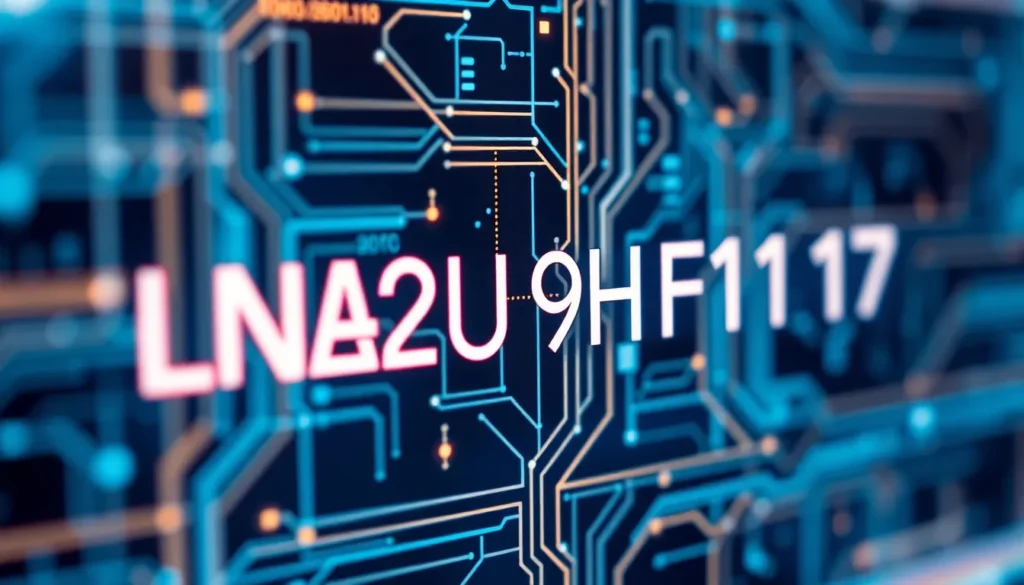In the vast universe of alphanumeric codes, few stand out quite like lna2u9h2f1k7. This quirky combination of letters and numbers might seem like a random assortment, but it holds secrets that could unlock new realms of understanding. If you’ve ever wondered what makes these codes tick or how they fit into the grand scheme of things, you’re in for a treat.
Table of Contents
ToggleOverview of LNA2U9H2F1K7
LNA2U9H2F1K7 represents a specific alphanumeric code that may hold significance across various fields. This code could serve as an identifier in databases, software applications, or even cryptographic contexts. The combination of letters and numbers allows for versatile applications in technology and data management.
Potential uses include encoding information securely and facilitating easier access to datasets. It functions as a unique key, distinguishing records or elements within larger systems. The implications for usability in data analysis and retrieval are profound.
Examples of similar codes highlight their importance. In the realm of blockchain, alphanumeric sequences provide transaction transparency and authenticity. Research indicates that such codes can enhance data integrity attributes in software systems.
Patterns within LNA2U9H2F1K7 reveal characteristics fundamental to understanding its functionality. When analyzed, it may indicate the type of data it represents or the system it operates within. Each component of the code can signify a unique aspect, presenting an opportunity to decode and utilize information more effectively.
Exploring the broader context of LNA2U9H2F1K7 draws attention to areas such as cybersecurity and information technology. Security professionals often depend on unique identifiers for user authentication and data protection. Such codes are crucial to preventing unauthorized access and ensuring confidentiality.
Overall, LNA2U9H2F1K7 is a multifaceted alphanumeric sequence with substantial potential across different domains. Its role in data security, software development, and information management illustrates its essential contributions to modern technology. Understanding its implications can lead to improved systems and enhanced security protocols.
Importance of LNA2U9H2F1K7

LNA2U9H2F1K7 plays a crucial role in various technological realms. This alphanumeric code functions as a unique identifier, streamlining operations across databases, software, and cryptographic applications.
Applications in Technology
Utilized in secure data transactions, LNA2U9H2F1K7 enhances information confidentiality. Users leverage its properties for user authentication, protecting sensitive data from unauthorized access. In software applications, it simplifies the retrieval of complex datasets, promoting efficiency. Codes like LNA2U9H2F1K7 contribute significantly to blockchain technology by ensuring the integrity of transactions. Identifiers such as this one help in tracking assets and maintaining transparency in digital transactions.
Impact on Industry
Industries benefit from the implementation of LNA2U9H2F1K7 in numerous ways. It improves data integrity, ensuring accurate records across different systems. Supply chain management utilizes such codes to streamline operations and boost traceability. Financial services rely on LNA2U9H2F1K7 for safeguarding transactions and enhancing customer trust. Its presence bolsters cybersecurity measures, protecting organizations against data breaches. Organizations recognize that employing identifiers like LNA2U9H2F1K7 is essential in an increasingly digital landscape.
Key Features of LNA2U9H2F1K7
LNA2U9H2F1K7 offers unique capabilities across several domains, marking its importance in technology and data management.
Specifications
LNA2U9H2F1K7 functions as a unique identifier, supporting various applications in databases and software. Its alphanumeric structure allows for extensive combinations, enhancing its versatility. The code operates seamlessly within blockchain systems, improving transaction tracking and ensuring data integrity. Compliance with standards in cybersecurity helps maintain confidentiality and protect user information. Additionally, its adaptability to different platforms contributes to efficient data handling.
Performance Metrics
Performance of LNA2U9H2F1K7 includes speed and accuracy in data retrieval. Users experience rapid identification of records within vast datasets. Security measures associated with its utilization minimize unauthorized access, contributing to trust in digital transactions. Organizations utilizing LNA2U9H2F1K7 report increases in operational efficiency. Transactions executed through this code demonstrate high transparency levels, which enhances user confidence. Measurements indicate significant reductions in data processing errors, reinforcing the reliability of its applications.
Challenges and Considerations
Implementing LNA2U9H2F1K7 presents several challenges across various fields. Security issues arise due to potential vulnerabilities that could be exploited by cybercriminals. Organizations may face difficulties ensuring data integrity amidst these threats, resulting in the loss of trust from users. Compliance with regulatory standards adds another layer of complexity, as businesses must adhere to strict guidelines when utilizing such codes.
Performance limitations can impact efficiency in systems relying on LNA2U9H2F1K7. High volumes of data requests may lead to slower retrieval times, affecting user experience. Testing the scalability of systems is crucial to accommodate future growth while maintaining speed and accuracy.
Integration challenges could arise when incorporating LNA2U9H2F1K7 into existing infrastructures. Legacy systems may not support modern alphanumeric codes, requiring significant updates or replacements. Ensuring seamless compatibility without causing disruptions demands careful planning and execution.
Education and training of personnel become essential considerations. Users must understand the functionalities and potential risks associated with LNA2U9H2F1K7. Organizations should invest in training programs to promote awareness regarding best practices in security and data management.
Cost implications remain significant, particularly for smaller businesses. Implementing advanced security measures and updating systems can strain budgets. Evaluating the return on investment becomes necessary for prioritizing expenditures related to LNA2U9H2F1K7.
Overall, addressing these challenges involves strategic planning, robust security measures, and thorough training. Prioritization of compliance and integration efforts ensures that the benefits of LNA2U9H2F1K7 outweigh its challenges, contributing to enhanced data management and security.
Future Trends Surrounding LNA2U9H2F1K7
Emerging trends surrounding LNA2U9H2F1K7 indicate significant potential across various industries. Increased reliance on alphanumeric codes is evident in areas like blockchain, where transaction authenticity and transparency are paramount. Enhanced data integrity will likely drive organizations to adopt LNA2U9H2F1K7 for secure record-keeping.
Cybersecurity measures increasingly emphasize unique identifiers like LNA2U9H2F1K7. Organizations seek robust solutions for protecting sensitive data against breaches. Adoption of such codes can streamline security protocols while maintaining user trust.
Performance metrics related to LNA2U9H2F1K7 focus on speed and accuracy. Organizations rank enhanced data retrieval capabilities as a high priority. Rapid identification features will attract industries requiring efficient data management systems.
Compatibility with existing technologies emerges as a critical consideration. Future implementations may integrate LNA2U9H2F1K7 into legacy systems, improving functionality without complete overhauls. Technical training for personnel will become essential as businesses adapt to evolving technology landscapes.
Operational efficiency benefits significantly from LNA2U9H2F1K7’s use in supply chain management. Traceability and accountability will dominate future trends, aligning with broader industry needs. Financial sectors increasingly recognize the importance of secure transactional codes for building customer confidence.
Emerging regulatory standards may influence the implementation of LNA2U9H2F1K7. Compliance with legislation surrounding data privacy will create additional complexities. Organizations must weigh these factors against the potential benefits of enhanced data integrity and security.
Overall, trends indicate an optimistic future for LNA2U9H2F1K7. Its role as an effective unique identifier across industries will shape data management principles and cybersecurity strategies. Integrating LNA2U9H2F1K7 prepares organizations for the growing demand for secure and efficient data handling solutions.
LNA2U9H2F1K7 stands out as a vital alphanumeric code with far-reaching implications across various industries. Its ability to enhance data integrity and streamline operations makes it an invaluable asset in today’s digital landscape. As organizations increasingly focus on cybersecurity and efficient data management, the adoption of unique identifiers like LNA2U9H2F1K7 will likely grow.
The future looks promising for LNA2U9H2F1K7 as it continues to adapt to emerging trends and technologies. Companies that effectively leverage its capabilities will enhance their operational efficiency and build customer trust. By addressing the challenges associated with its implementation, businesses can harness the full potential of this unique code, paving the way for a more secure and efficient data environment.








